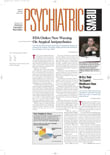That almond-shaped, fear-response center in the brain is again sounding an alarm about its involvement in anxiety disorders.
The amygdala is known to be involved in social anxiety, posttraumatic stress, and obsessions and compulsions (Psychiatric News, December 17, 2004; June 4, 2004). It is now being linked with separation anxiety and general anxiety.
A study that uncovered this relationship was conducted by scientists at the National Institute of Mental Health's Mood and Anxiety Disorders Program. The lead investigator, Michael Milham, M.D., Ph.D., is a psychiatry resident at New York University and an associate research scientist at the New York University Child Study Center. Study results are in press with Biological Psychiatry.
Milham and his colleagues used a brain-scanning technique called voxel-based morphometry (VBM) to examine gray-matter volume in the brains of 51 children.
Seventeen of the children had one or more of the following: general anxiety disorder, social anxiety disorder, or separation anxiety disorder. The remaining 34 children had no mental illness and served as age-matched, gender-matched, I.Q.-matched controls. (There were two control subjects for every anxiety subject.) The scientists then compared the brain volumes of subjects with the anxiety disorders with those of the control subjects.
They found only one statistically robust difference in brain volume between the two groups—a small left amygdala in the youngsters with anxiety disorders.
“While on the one hand we were not surprised to find reductions in amygdala gray-matter volume given our hypothesis that abnormalities within an amygdala-based neural network underlie pediatric anxiety disorders,” Milham told Psychiatric News, “we were surprised by our finding that reductions in volume were so specific—that is, limited to the amygdala.”
Moreover, seven of the 17 subjects with social, separation, or general anxiety were then treated with either an SSRI antidepressant or with psychotherapy for eight weeks. After that, scans of their pre- and posttreatment brain volume were compared. A significant increase in the size of the left amygdala was noted after treatment in all seven subjects.
These findings have some clinical implications.
“Clearly, the decision to diagnose and treat children with anxiety disorders should rest on the observation that these conditions are associated with significant suffering and clinical impairment, independent of any detected biological abnormalities,” Milham and his colleagues pointed out. “Nevertheless, documenting biological correlates of pediatric anxiety disorders may facilitate efforts to eventually ground clinical approaches to these conditions on pathophysiologic models derived from research in the neurosciences.”
As for the results suggesting that treatment increased the size of the left amygdala, the “data are preliminary, given the small sample size and unavailability of matched-rescanned healthy comparisons,” Milham and his team acknowledged. “Nevertheless, they illustrate the potential for effective treatment to reverse underlying abnormalities in neurobiology.”
The findings also raise some questions. What does a smaller left amygdala actually mean as far as childhood anxiety is concerned? “Interestingly, our findings of reduced left amygdala... volume overlap with those typically noted in adult major depressive disorder,” Milham and his coworkers noted in their report. “Thus, our data suggest the association between childhood anxiety and adult major depressive disorder might reflect neurodevelopmental dysfunction in a neural circuit encompassing the amygdala.”
Why has an abnormally small left amygdala been linked with social anxiety, separation anxiety, and general anxiety in children, yet an abnormally large left amygdala has been found in children with obsessive-compulsive disorder?“ This is an interesting question for which a few possible explanations exist,” Milham told Psychiatric News. “First, the differences. .may reflect a fundamental difference in the neurobiological abnormalities underlying pediatric anxiety disorders and obsessive-compulsive disorder. Alternatively, it may reflect differences in subject-selection criteria.... Finally, it is important to note that we made use of voxel-based morphometry, while other studies made use of manual tracings—each with their advantages. I believe further work is merited to differentiate between these possibilities.”
Milham does not have an explanation for how these new findings might mesh with an earlier discovery—that persons who possess a short version of the gene that codes for a serotonin transporter are especially prone to anxiety, yet exhibit excessive activity in the right, not the left, amygdala.
